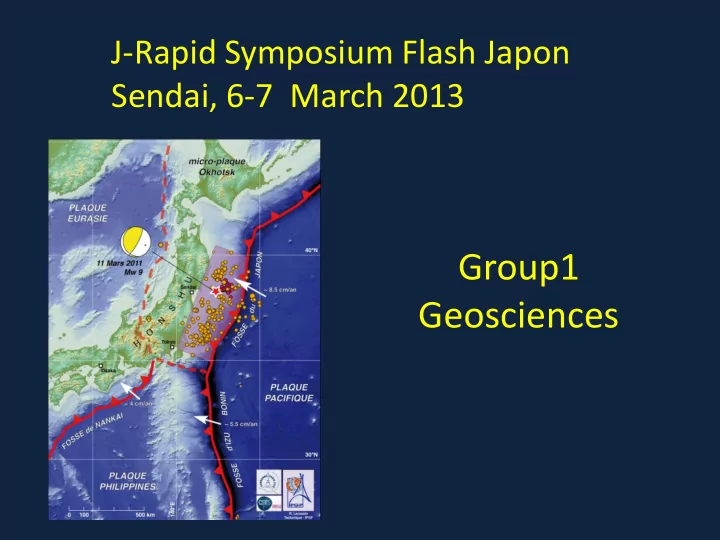

J-Rapid Symposium Flash Japon Sendai, 6-7 March 2013 Group1 Geosciences
Projects • Rapid response geophysical survey in the fault zone. Sh. Kodaira and G. Moore (U.S.A.) • Urgent surveys for evacuation measures from unextpected large tsunami . K. Satake and H. Harjono (Indonesia) • Evaluation potential of large aftershocks. Yo Fukushima P. Segall (U.S.) • DYNTOHOKU. S. Ide and R. Madariaga (France) • Tohoku Oki from Earth to Oceans and Space Sh Watada and A. Sladen (France) • Crustal seismic velocity changes and deformation T. Nishimua and F. Brenguier (France) • Paleoseismology and paleotsunamis of the NE Japan subduction zone. Sh. Toda and M. Meghraoui (France)
Major questions about the Tohoku earthquake 1. Why was it unexpected? 2. What did actually happen and will happen? 3. Why did it grow to be so big? 4. How can we better observe future mega-thrust earthquakes ?
Why did we not expect it? Interpretation of Historical seismicity of Tohoku Expected Earthquake M~8 http://www.j-shis.bosai.go.jp/map, ca. 2010 Abe et Kanamori et al, 1970s
Simulation of a possible tsunami source based on Jogan Earthquake of 869 Improved paleoseismology Toda and Meghraoui Minoura et al, 2001
What did actually happen? Many Satake Harjono Tsunami height Slip on the fault Fujii-Satake, 2011 Nishimura et al, 2011-13
What did actually happen? The source of high frequencies is not the same as the source of low frequencies. Ide and Madariaga Satake Harjono (Nishimura Brenguier)
What did actually happened and will happen? Geodesy local Coseismic (120 s) Inter-seismic Post seismic (10 years?) (>1000 years) From Roger Bilham, http://cires.colorado.edu/~bilham/Honshu2011/Honshu2011.html
1. What did actually happen and what will happen ? We only have 20 years of geodetic data for an earthquake that took at least 1000 to prepare. And we can only observe in the surface . Fukushima Segall classical and modern geodesy Ide Madariaga GPS near and far field Nishimura Brenguier local GPS Toda Meghraoui coastal deformation
Why did it grow to be so big? Kodaira and G.F. Moore Ide and Madariaga Affects rupture process (Ide+Madariaga) Affects tsunami generation (Satake+Harjono Watada+Sladen)
How can we better observe future mega-thrust earthquakes ? Use space observations: infrasounds, GPS observed in the upper atmosphere, etc Watada-Sladen Detect velocity changes using seismological methods (coda waves, noise crosscorrelations) T. Nishimura, F. Brenguier
Recommend
More recommend